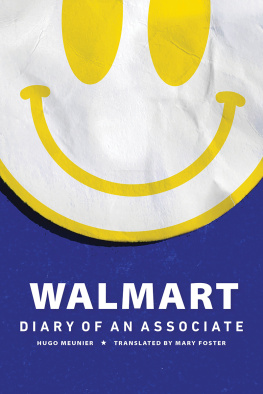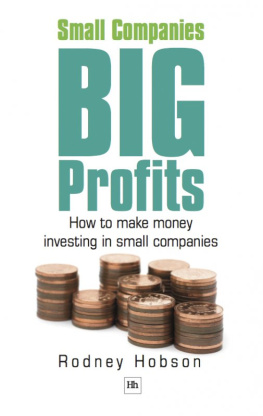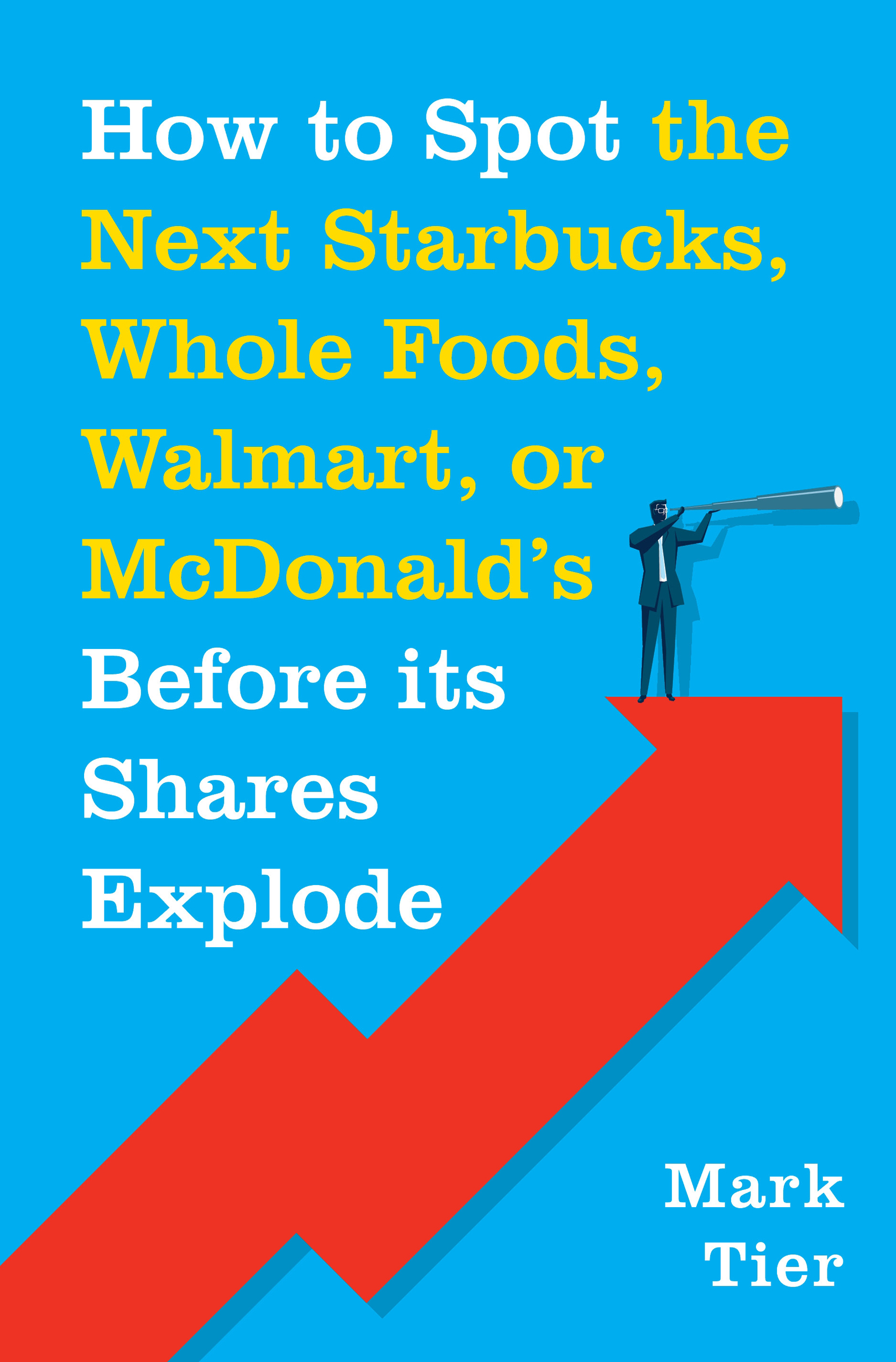Contents
Guide
Pagebreaks of the print version

The author and publisher have provided this e-book to you for your personal use only. You may not make this e-book publicly available in any way. Copyright infringement is against the law. If you believe the copy of this e-book you are reading infringes on the authors copyright, please notify the publisher at: us.macmillanusa.com/piracy.
 Why does Starbucks have more stores than any other coffee company, and not Peets (which had a twenty-year head start on Starbucks), Seattles Best, or someone else?
Why does Starbucks have more stores than any other coffee company, and not Peets (which had a twenty-year head start on Starbucks), Seattles Best, or someone else?
 What turned an upstart discounter named Walmart into the worlds biggest and most profitable retailer, and one of the worlds top two companies by sales? While passing the then much larger Kmart and Target chains to become bigger than both of them combined?
What turned an upstart discounter named Walmart into the worlds biggest and most profitable retailer, and one of the worlds top two companies by sales? While passing the then much larger Kmart and Target chains to become bigger than both of them combined?
 How come Ray Krocs McDonalds gained the first mover advantage to become the worlds biggest hamburger chain, while Burger King, which had a two-year head start, lost theirs? And a third burger chain, Burger Chef, which was within shooting distance of taking the number one spot from McDonaldswent out of business instead?
How come Ray Krocs McDonalds gained the first mover advantage to become the worlds biggest hamburger chain, while Burger King, which had a two-year head start, lost theirs? And a third burger chain, Burger Chef, which was within shooting distance of taking the number one spot from McDonaldswent out of business instead?
 And why was Whole Foods, of the hundreds of specialty grocers in the United States when it opened its doors, the one that grew to dominate its market?
And why was Whole Foods, of the hundreds of specialty grocers in the United States when it opened its doors, the one that grew to dominate its market?
What, to summarize, are the crucial differences that make the difference between a good company and a great growth stock?
These are the questions that well be examiningand answeringhere. The aim is to give you the tools and the concepts you need to identify the next start-up company that could follow in the footsteps of these four.
Tools that can also be applied to start the next Starbucks yourself.
And with numbers like these, who wouldnt want to get in on the ground floor?

By comparing Starbucks pattern of growth to that of other high-growth companies, we can single out the five significant factors they all have in common. The practices that made Starbucks, McDonalds, Walmart, Whole Foods, and their ilk tower above their many competitors.
Once weve identified the differences that make the difference, they become:
The 5 Clues to Spotting the Next Starbucks
 They permanently change peoples habits: McDonalds permanently changed the way we eatindeed, McDonalds kicked off the fast-food business as we know it today. Walmart and Whole Foods changed the way people shop; and before Starbucks, how many Americans had heard of a $4 latte, let alone drunk one?
They permanently change peoples habits: McDonalds permanently changed the way we eatindeed, McDonalds kicked off the fast-food business as we know it today. Walmart and Whole Foods changed the way people shop; and before Starbucks, how many Americans had heard of a $4 latte, let alone drunk one?
 Theyre copycats: Ray Kroc duplicated the original McDonald brothers store worldwidelock, stock, and barrel.
Theyre copycats: Ray Kroc duplicated the original McDonald brothers store worldwidelock, stock, and barrel.
 Their success is validated by competition: There are thousands of Starbucks, McDonalds, Walmart, and Whole Foods clones around the worldwith more opening just about every day. Competition proves the founders concept and demonstrates that the potential size of the market is enormous. A company that does not inspire competition is destined to serve a small market niche.
Their success is validated by competition: There are thousands of Starbucks, McDonalds, Walmart, and Whole Foods clones around the worldwith more opening just about every day. Competition proves the founders concept and demonstrates that the potential size of the market is enormous. A company that does not inspire competition is destined to serve a small market niche.
 Theyre driven by the founders vision and passion: A company whose management doesnt inspire its employees wont inspireand keepits customers. The founders of Starbucks (Howard Schultz), Whole Foods (John Mackey), Walmart (Sam Walton), and McDonalds (Ray Kroc) all successfully transmitted their vision and passion throughout their companies, translating it into a unique customer experience.
Theyre driven by the founders vision and passion: A company whose management doesnt inspire its employees wont inspireand keepits customers. The founders of Starbucks (Howard Schultz), Whole Foods (John Mackey), Walmart (Sam Walton), and McDonalds (Ray Kroc) all successfully transmitted their vision and passion throughout their companies, translating it into a unique customer experience.
 They have superb entrepreneurial management and execution: Thousands of good to great businesses share the first four characteristics, but without entrepreneurs at the helm who also have superb management and execution skills, theyre destined to remain small, or even one-man bands.
They have superb entrepreneurial management and execution: Thousands of good to great businesses share the first four characteristics, but without entrepreneurs at the helm who also have superb management and execution skills, theyre destined to remain small, or even one-man bands.
None of these factors is necessarily unique to a growth company. But when you find all five together in one company, you can be pretty confident that youve found a great candidate for the next high-growth stock.
But how can you, as an average investor in the street, find such a hot growth stock? Especially when you have no access to top management, no insider information, and no hope of getting any and would rather go to Starbucks than read its annual report?
While its not easy, its a lot easier than you probably think.
The first step is to appreciate how and why companies that faithfully practice the five clues inevitably outstrip competitors that dont.
This is the subject of part 1, where we compare Starbucks, McDonalds, Walmart, and Whole Foods with each otherand with their various competitors that fell behindto see exactly how and why the clues separate a great company from a merely good one.
In part 2, we apply the resulting framework to see how it is possible to identify a great companywhen it is still small.
Youll end up with detailed techniques you can apply to spot a high-growth stockand just as importantstrike the next turkey off your list.
Youll also discover
 Nine ways to spot the next Starbucks by just walking around.
Nine ways to spot the next Starbucks by just walking around.
 How you can apply the five clues to dig up hidden gems and beat the Wall Street expertsfrom the comfort of your own home.
How you can apply the five clues to dig up hidden gems and beat the Wall Street expertsfrom the comfort of your own home.
 Four completely different ways to profit from the next hot growth stockor the last one.
Four completely different ways to profit from the next hot growth stockor the last one.
 How to weed out the dross by reading between the lines of a companys annual reporteven if the last thing youd want to do is take Accounting 101.
How to weed out the dross by reading between the lines of a companys annual reporteven if the last thing youd want to do is take Accounting 101.
 Andparadoxicallyyoull also learn there will be times when you can make more money more easily by investing in the last Starbucks (or one of its competitors), not the next one.
Andparadoxicallyyoull also learn there will be times when you can make more money more easily by investing in the last Starbucks (or one of its competitors), not the next one.
Applying the five clues to identify the next growth company has a surprising side effect: identifying the ingredients essential for a small business to become a big one becomes a recipe for starting a successful business of your own.
Which means, rather than investing in the next Starbucks, you could decide to create it yourself!
Starbucks opened its first European store in 1998in the UK.
As I write these words in mid-2017, the only countries in Western Europe that do not have a Starbucks are the small and mostly poorer markets of Albania, Bosnia, Croatia, Liechtenstein, Macedonia, Malta, Serbia, and Slovenia.









 Why does Starbucks have more stores than any other coffee company, and not Peets (which had a twenty-year head start on Starbucks), Seattles Best, or someone else?
Why does Starbucks have more stores than any other coffee company, and not Peets (which had a twenty-year head start on Starbucks), Seattles Best, or someone else?